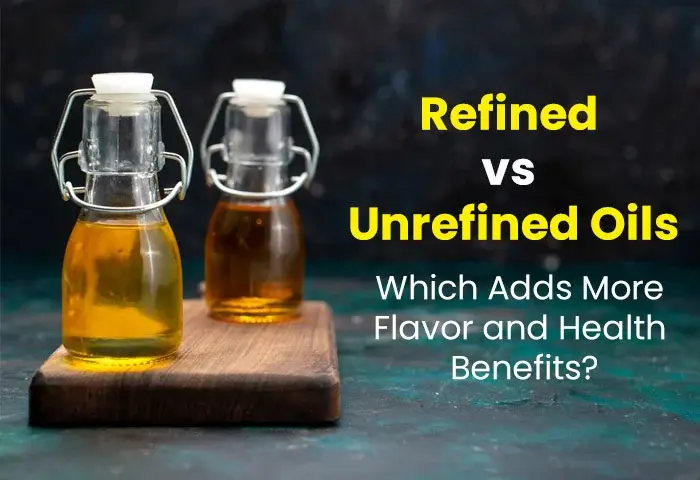In the world of culinary delights and health-conscious choices, the type of oil we choose can make a significant difference in both flavor and nutritional value. The market is flooded with a myriad of options, but at the core of this oily dilemma lies a fundamental choice – refined or unrefined oil. Understanding the distinctions between these two types of oils is crucial for anyone looking to make informed decisions about their cooking and dietary habits.
Oil, often referred to as “liquid gold,” serves as a staple in kitchens worldwide. Beyond its culinary applications, oil plays a pivotal role in various industries, ranging from cosmetics to pharmaceuticals. With the shelves lined with choices ranging from clear and pristine to robust and unfiltered, it’s essential to grasp the nuances between refined and unrefined oil to unlock the full potential of this liquid treasure.
Rice bran oil is one of the best cooking oils for your heart and cholesterol-level management. Read more about rice bran cooking oil heart benefits.
This blog aims to unravel the mystery surrounding refined and unrefined oils, shedding light on their production processes, nutritional profiles, and the impact they can have on our overall well-being.
Read this blog as we have explained the refined and unrefined realms of oil and discover the importance of understanding the diverse landscape of oil varieties.
What Is Refined Oil?
Refined oil, simply put, is oil that has undergone a meticulous process of purification to remove impurities, unwanted substances, and flavors. The goal is to create an oil with a neutral taste, a higher smoke point, and a longer shelf life. Commonly used refined oils include vegetable, canola, and sunflower oil, among others.
If you are looking for the best option for cooking oil, refined rice bran oil is a good option because of its high smoking point and capability of increasing HDL, or good cholesterol. Find out more about rice bran oil.
The Refining Process: A Journey from Crude to Culinary Elegance
The refining process is a series of carefully orchestrated steps designed to enhance the quality and characteristics of crude oil. Here’s a step-by-step breakdown:
- Degumming:
The journey begins with the removal of phospholipids and other impurities known as gums. This process ensures a smoother oil consistency and prevents cloudiness.
- Neutralization:
In this phase, the oil is treated with an alkaline substance to neutralize free fatty acids. The result is a reduction in acidity, contributing to a milder taste and improved stability.
- Bleaching:
To eliminate pigments and traces of impurities, the oil undergoes a bleaching process. This step enhances the oil’s color and clarity, creating a more visually appealing end product.
- Deodorization:
Unwanted odors and flavors are stripped away through the deodorization process, where the oil is subjected to high temperatures under a vacuum. This step is crucial in achieving a neutral taste and aroma.
- Filtering:
The final touch involves thorough filtration to remove any remaining particles or impurities. This ensures that the refined oil is pristine and ready for consumption.
Natural Goodness of Unrefined Oils
Unrefined oils are crafted with a commitment to preserving the natural essence of the source material. The processing of unrefined oils is a testament to the art of minimalism, avoiding excessive heat and chemical treatments that can compromise the inherent qualities of the oil. The typical journey involves mechanical pressing or cold-pressing methods, ensuring that the oil retains its original flavors, colors, and nutrients.
- Cold-Pressing: A Gentle Embrace
Cold-pressing, a common method for extracting unrefined oils, involves pressing the seeds or fruits at lower temperatures. This gentle approach helps to maintain the delicate balance of nutrients, antioxidants, and flavor compounds. The result is an oil that encapsulates the essence of the plant from which it originates.
- Minimal Processing: Nurturing Nature’s Bounty
Unlike refined oils that undergo extensive processing, unrefined oils often undergo minimal filtration. This means they may retain some sediment or particles, a visible reminder of their natural origin. While this might seem unconventional, it’s a testament to the commitment to preserving the oil in its most authentic form.
Advantages:
- Rich in Nutrients: A Nutritional Powerhouse
One of the standout advantages of unrefined oils lies in their nutritional potency. The minimal processing ensures that essential vitamins, minerals, and antioxidants remain intact. Whether it’s the robust flavor of unrefined olive oil or the nutty notes of unrefined sesame oil, these oils deliver not just taste but a nutritional punch as well.
- Authentic Flavor Profile: Nature’s Symphony
Unrefined oils boast a more pronounced and authentic flavor profile compared to their refined counterparts. The nuances of the source material shine through, enhancing the overall sensory experience of your culinary creations.
- Preserving Natural Colors: A Feast for the Eyes
The unfiltered nature of unrefined oils often means they retain their natural colors. From the vibrant green of unrefined avocado oil to the deep amber hues of unrefined sunflower oil, these oils add not just flavor but a visually appealing touch to your dishes.
Cold-Pressed Oil vs. Refined Oil:
Cold-Pressed Oil vs. Refined Oil: Nourishing Your Body with Liquid Gold
In the quest for healthier cooking oils, the choice between cold-pressed and refined oils has become a hot topic among health-conscious consumers. The cold-pressed method, celebrated for preserving the natural goodness of oils, stands in stark contrast to the widely used refining process. Let’s delve into the world of “cold-pressed oil vs. refined oil” and uncover the nuances that can impact your health, culinary experience, and overall well-being.
The Cold-Pressed Advantage:
Cold-pressed oils are extracted through a mechanical process that involves pressing seeds or nuts without the use of heat. This method, often associated with artisanal production, results in oils that retain more of their natural flavors, colors, and nutritional benefits. The absence of heat during extraction helps to preserve delicate compounds, such as antioxidants and vitamins, making cold-pressed oils an attractive option for those who prioritize the nutritional integrity of their cooking oils.
These oils often carry a distinct, robust flavor that adds depth to dishes, appealing to chefs and food enthusiasts seeking an authentic and rich culinary experience. Additionally, the cold-pressed method typically involves minimal processing and no chemical additives, aligning with the preferences of consumers who favor natural and minimally processed food products.
Nutrition Showdown: Cold-Pressed vs. Refined:
When it comes to nutritional content, cold-pressed oils have a leg up on their refined counterparts. The refining process, designed to remove impurities and extend shelf life, can inadvertently strip oils of certain nutrients. Cold-pressed oils, on the other hand, retain a higher concentration of vitamins, minerals, and beneficial fatty acids. For health-conscious individuals aiming to maximize the nutritional value of their meals, opting for cold-pressed oils is a wise choice.
Flavorful Escapade:
In the battle of flavors, cold-pressed oils emerge as victors. Their unrefined nature preserves the inherent tastes and aromas of the source ingredients. Whether it’s the peppery notes of extra virgin olive oil or the nutty undertones of cold-pressed almond oil, these oils contribute a distinct and authentic flavor profile to your dishes. Refined oils, often treated to remove strong flavors and odors, may lack the complexity and richness that many culinary enthusiasts seek.
Usage Insights: Smoke Point Dynamics:
One crucial factor to consider in the cold-pressed oil vs. refined oil debate is their respective smoke points. The smoke point refers to the temperature at which an oil begins to break down and produce smoke, affecting both flavor and nutritional quality. Cold-pressed oils generally have lower smoke points, making them suitable for light sautéing, dressings, and drizzling over finished dishes. Refined oils, with higher smoke points, are better suited for high-heat cooking methods like frying and deep frying.
When to use Refined and unrefined oil
Choosing between refined and unrefined oils can significantly impact the outcome of your culinary creations. Each type has its unique qualities, making them better suited for specific cooking applications.
Refined Oil
High-Heat Cooking:
Refined oils, such as refined vegetable or canola oil, are ideal for high-heat cooking methods like frying and sautéing. Their higher smoke points ensure that the oil remains stable at elevated temperatures, preventing it from breaking down and producing undesirable flavors.
Neutral Flavor Profile:
When you want the natural flavors of your ingredients to shine without any interference from the oil, refined oils are the go-to choice. They have a neutral taste, making them versatile for a wide range of recipes where you want the other ingredients to take center stage.
Longer Shelf Life:
Refined oils often have a longer shelf life compared to their unrefined counterparts. The refining process removes impurities and elements that can contribute to rancidity, resulting in a more stable oil that can last longer in your pantry.
Unrefined Oil
Low-Heat Cooking and Dressings:
Unrefined oils, such as extra virgin olive oil or cold-pressed coconut oil, are best reserved for low to medium-heat cooking or used as finishing oils. Their lower smoke points make them unsuitable for high-temperature cooking, but they excel in salad dressings, drizzling over dishes, and for adding a burst of flavor to already-cooked meals.
Rich Flavor Profile:
If you’re aiming to infuse your dishes with a distinct, robust flavor, unrefined oils are the way to go. These oils retain more of the natural flavors and aromas of the source ingredients, providing a unique and authentic taste to your culinary creations.
Nutrient Retention:
Unrefined oils often retain more of the natural nutrients present in the original source, such as antioxidants and vitamins. For those seeking the potential health benefits of oils beyond their cooking function, unrefined options offer a more nutritionally dense choice.
Conclusion
As you stand at the crossroads of refined and unrefined oils, armed with knowledge, you hold the key to transforming your culinary experiences. The world of cooking is not just about flavors and aromas; it’s about making choices that resonate with your well-being. By embracing the diversity of oils and understanding their roles in your kitchen, you embark on a journey toward a healthier and more satisfying lifestyle.
Contact us today to learn more about our product and services.
FAQ’s
Q: Which refined oil is best for health?
A: The best-refined oil for health depends on individual preferences and dietary needs. Options like rice bran oil, olive oil, canola oil, and sunflower oil are considered healthy due to their high unsaturated fat content. It’s advisable to choose oils low in saturated fats and rich in heart-healthy fats for optimal health benefits. Always consult with a nutritionist for personalized advice.
Q: What is the meaning of physically refined oil?
A: Physically refined oil is a type of oil that undergoes a refining process without the use of chemicals. It is refined through physical methods like steam distillation and deodorization, preserving the oil’s natural properties while removing impurities.

